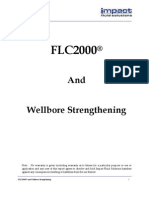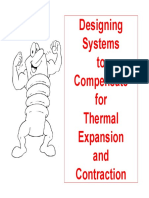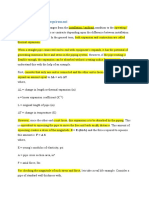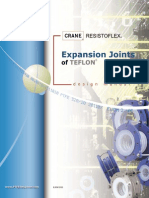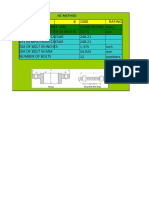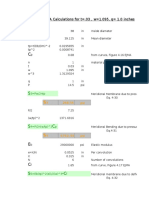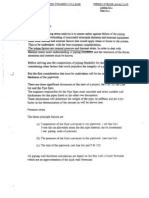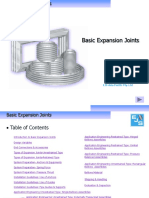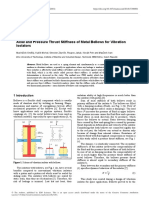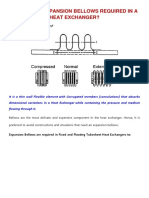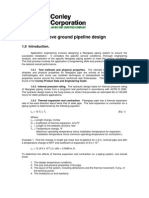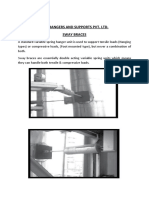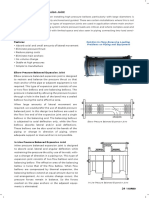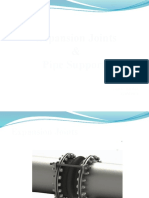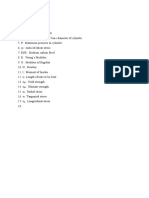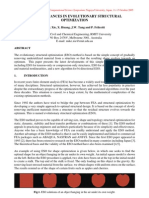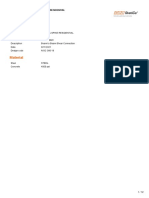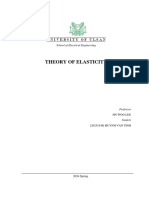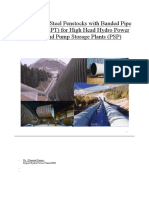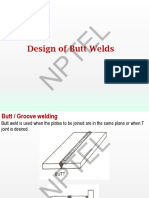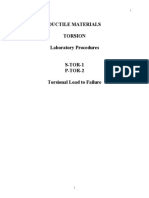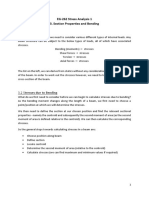Bellow Design Guide
Bellow Design Guide
Uploaded by
lokeshraja007Copyright:
Available Formats
Bellow Design Guide
Bellow Design Guide
Uploaded by
lokeshraja007Copyright
Available Formats
Share this document
Did you find this document useful?
Is this content inappropriate?
Copyright:
Available Formats
Bellow Design Guide
Bellow Design Guide
Uploaded by
lokeshraja007Copyright:
Available Formats
BELLOW DESIGN GUIDE
Design guide for bellows An expansion joint is a device containing one or more bellows used to absorb dimensional changes in the piping system while maintaining pressure integrity .Design of bellow involves the evaluation of many often conflicting criteria such as pressure capacity, fatigue life , & spring rate. A bellow is a flexible element of the expansion joint consisting of one or more convolutions & the end tangents with Lb/Db < 3 .Total movement capacity of a bellows is proportional to the number of convolutions. Bellow expansion joints are employed in piping systems to absorb differential thermal expansion while containing the system pressure . The ability of bellow to carry pressure is limited by hoop stress or S2 (defined in EJMA- this is the stress that runs circumferentially around the bellows due to the pressure difference between the inside & the outside of the bellows) . hoop stress holds the bellow together & should be limited to code stress level. The bellows ability to carry pressure is also limited by bulge stress S4 (this stress runs logitudinal to the bellows centreline , it is located in the bellow side wall & is measure of the tendency of convolutions to become less U shaped or more spherical.For bellows that are not annealed after forming ,S4 is allowed by EJMA to exceed the initial yield strength of the bellows material by a large margin because it is cold worked . If a bellow is annealed after forming , S4 must be severly limited because the bellows sidewall material is no longer cold worked. Heat treatment of bellows after forming convolutions can lower bellow spring rate squirm pressure, & cycle life The value of (S3 +S4 ) must be limited to 1.5 times the allowable stress for annealed bellows & 3 times the allowable stress for bellows in the as formed condition. When a bellow deflects , bending of the side walls of each convolutions absorb the motion. The associated stress caused by this motion is deflection stress S6.(this stress runs longitudinal to the bellow centreline. Deflection bending stress is the primary bending stress influencing fatigue life .The maximum value of S6 is located in the sidewall of each convolutions near the crest or root.Expansion joints are designed to operate with a value of S6 that far exceeds the yield strength of the bellow material . This means that most expansion joints will take permanent set at the rated axial , angular or lateral motion. Expansion joint bellows are rarely designed to operate in the elastic stress range . There fore the bellow will eventually fatigue after a finite number of movement cycles . The total deflection stress range in the bellows for a typical cyclic movement application will exceed the yield strength & may have a total strain range in excess of 1%.
For a bellow , instability corresponds to a condition where a small increase in the internal pressure will result in a large change in shape. Squirm is said to occur when the bellow deforms such that the ratio of the maximum convolution pitch under internal pressure to the convolution pitch before application of pressure exceeds 1.15 .For a single bellow , column squirm is defined as a gross lateral shift of the centre section of a bellow while the end remain fixed.F or a universal type expansion joint with two bellows,column squirm results in curvature of the bellows centrelines & lateral movement or rotation of the centre pipe spool .For universal expansion joint with initial lateral offset pressure forces are resisted by combined axial & angular spring stiffness. Each increase in pressure produce a corresponding nonlinear jump in lateral deflection .There are two types of squirm or instability that can occur for internally pressurised bellows. One is called column squirm & the other is called in-plane squirm (localised plastic deformation). Limiting design pressure based upon squirm for a universal expansion joint with initial lateral offset, straight centre spool & fixed ends Ps =0 .44 Pe Where Pe= The following acceptance criteria should be used to evaluate bellow squirm at design pressure P< Ps Where Ps is based upon the actual measured or calculated bellows metal temperature under operating conditions To evaluate bellow squirm at test pressure , the following acceptance criteria should be used Pt<1.5 Ps Where Ps is based upon room temperature material properties.if the test pressure , adjusted for temperature will produce a membrane stress in excess of the yield strength or cause permanent deformation or instability (squirm) of the bellow at the test temperature, the test pressure may be reduced to the maximum pressure that will not exceed yield or cause instability. Squirm pressure capacity can be increased by changes such a thicker material more plies,lower convolution height,& high yield strength. The stress where plasticity begins is proportional to the yield strength of the material. Therefore , the in-plane squirm pressure which is based on the formation of plastic hinges at the root & crest of the convolutions will also be proportional to the yield strength of the material. Also The generalised form of equation for average in-plane squirm pressure would be P =( 3.14 n tp2 y)/ (w2Cp ) A internally pressurised expansion joint will eventually buckle or squirm at some internal pressure loading. The critical pressure at
which the instability occurs is a direct function of diameter & spring rate & an inverse function of length.As the length increases , the tendency to squirm increases & the stresses become higher & higher untill catastropic failure occurs. A bellow is flexible in the axial direction , it can increase its volume by increasing the length of its centreline . With the ends fixed , it does so by simulating the appearance of the buckling column.The expansion joint will not resist any deflections with any force other than the resistance of the bellow, which is a fuction of spring rate times the deflection amount. Liner is a longitudinally welded tube attached at one end to the upstream end connection Angular rotation can be accomodated only if two tie rods are used & located 90 degrees opposed to the direction of rotation. When bellow is compressed in operation , use (+) ; when extended use (-) Control rods are not designed to restrain pressure thrusts Do not use graphite impregnated gaskets in contact with stainless steel facings or sleeves. Nickel alloys are typically specified for steam service to avoid chlorideinduced stress corrosion. Pressure thrust on the main anchor is a function of the pressure times the cross-sectional area of the expansion joints. Tie rods are tension devices which act the same as the pipe wall in resisting or carrying the pressure thrust. The advantage of the pantagraph is that it automatically distributes the axial deflection equally between the two bellows without the addition of other devices. Externaly pressurised inline pressure balance bellow The pressure balanced expansion joint is used to relieve loads on equipment such as pumps, compressors & turbines. A pressure balanced expansion joint is designed to absorb axial movement & or lateral deflection while restraining the pressure thrust by means of tie devices inter-connecting the flow bellows with an opposed bellows also subjected to line pressure.the major advantage of pressure balanced design is its ability to absorb externally imposed axial movement without imposing pressure loading on the system. But the force resulting from the bellow spring rate is not eliminated. In case of inline pressure balance bellows pressure thrust is restrained by means of tie devices interconnecting the line bellows with outboardcompensating bellows also subjected to line pressure. In order to accomplish this balancing , a constant volume device is used by addition of a balancing bellows with a cross sectional area equal to twice the cross sectional area of the line or pipe size bellows.through proper cross linking the change in volume of the line bellows, due to an axial change in length , ie expansion contraction can be made to cause an equal but opposite change in volume of the
balancing bellows.Using the principles of mechanics & hydraulics , if no volume change occurs, then all pressure forces remain constant & there are no forces out of balance thus the pressure thrust force is eliminated. Main features of this bellow 1) twice the cross section area of line bellow. 2) functions as a constant volume device by cross linking the change in volume of the line bellows. 3) when the line bellow contract , an equal & opposite expansion occur in the balancing bellows 4) volume remains unchanged, therefore all forces remain constant & balanced , eliminating axial pressure thrust forces on the piping system In order for a pressure balanced expansion joint to function properly , the pressure thrust restrained by the tie rods must exceed the axial movement forces of the expansion joint. In a large diameter , low pressure application ,it may be impossible to utilise the pressure balanced expansion joint to eliminate the pressure loading or , at best the effect may be uncertain. Also pressure balanced expansion joints are not recommended for use in services where the pressure equalising connection between the flow bellows & the balancing bellows may become plugged or blocked by the flowing medium or by conaminants. buckling of pipe due to the compression effects of a pressurised fluid column . In a tension system , where normal longitudinal tensile load is maintained , this cannot happen , no matter how long the unsupported (or guided) length of pipe Where as in compression system , a column buckling effect can occur , even when there is no externally generated longitudinal compression load on the pipe. Normally with a bellow there is a longitudinal compression in the pressurised pipe due to bellow sidewall load.however it is the full bellow thrust area which determines the buckling pressure. A pipe with ends sealed , but not restrained is filled with fluid & subjected to internal fluid pressure . at a certain critical compressive force Fcr & corresponding internal fluid pressure Pcr the pipe will buckle . guides are required to prevent such buckling. Thus the pressurised column of fluid is inherently unstable & depends on the flexural rigidity of the pipe for its stability Fcr= 2 EI/L2 Where Fcr =Pcr x Ae & critical buckling pressure Pcr=(2 EI/L2 ).Ae bellow thrust load is carried by hinge bars , gimbals , tie rods or other such devices hence normal tension is maintained in the pipe system & main anchors & full lateral restraint guides are not necessary.
Longitudinal pressure PA load is carried in tension in the pipe wall in a conventional piping system without bellows .In a system with a bellows the pipe internal fluid pressure load is not balanced by pipe longitudinal tensile forces & must be restrained by external forces . it can also be seen that if the bellows ID exceeds the pipe ID , an additional pressure force will be transmitted through the pipe as a compression load which must also be externally restrained. Bellow ID area =/4 x ID2 Corrugation side wall thrust internal fluid pressure acting on the sidewall of the corrugation would tend to spread the corrugation out in the longitudinal direction & this load must be restrained by an external reaction force . one half of corrugation sidewall load is carried in tension at the crest of the corrugation. The other half is transmitted through the neck of the corrugation as a compressive force . this force must be resisted by external main anchors & results in a longitudinal compressive stress in the pipe Side wall effective area = /4 (Dm)2 /4 ID2 Where Dm =ID + h Therefore total effective area = bellow ID area + Side wall effective area =/4 xDm2 bellow effective area is the area of the bellows that create pressure thrust when acted upon by the operating pressure.the system anchor & hardware of expansion joint must be designed to withstand pressure thrust at the operating & test conditions. 0 The bellow PA load is based on the bellow mean diameter Bellow thrust load PA = /4 Dm2 x p Bellow forming- metal bellows are formed by methods that produce permanent strain or cold work in the material.Cold work improves yield strength while retaining a high degree of elongation.The effect of cold work diminishes when the material is exposed to high temperature .(enhanced mechanical properties from cold work actually diminish in the high temperature range) . In high temperature range , cold work can reduce the stress for rupture below that for annealed material. Cold work in the material can limit the amount of inelastic strain that can be accumulated over the expected life time of the bellows. Hence annealing after forming to eliminate the effect of cold work should be considered for bellows that have ABMT in the creep range. & If the bellows are annealed , consideration must be given in the calculations to account for the reduced material strength.For temperature above creep range, none of the standard bellow design methods currently provide cycle life equations or temperature correction factor
Bellow annealing In radial outward forming a small thinning occurs but this is compensated by an increase in yield strength due to cold work. When the bellows are subsequently annealed , the increase in yield is eliminated.As formed yield strength is usually double the specification minimum annealed strength . Increased yield results in increased convolution deformation pressure & in plane squirm pressure increase. Also , plastic strain due to deflection is reduced & this results in increased fatigue life . The work hardening of austenitic stainless steel induced during the forming of convolutions generally improves the fatigue life of an expansion joint,often to a marked degree ; thus it is not normally considered beneficial to either stress relieve or anneal after forming. In forming high yield strength material such as inconel 625 , an interstage anneal may be required. However annealing is not recommended after forming. Design movements create the deflection stress that determine cycle life . one complete cycle is based upon moving the bellows from the installed position to the maximum specified movement & then back to the installed position. Operation of high-temperature , metal bellow expansion joint can be improved by using actual bellow material temperature (ABMT), considering the effect of cold work & reducing deleterious thermal stress concentrations. Since the bellow itself is physically removed from direct exposure to the flow stream , the actual ABMT is rarely as high as the temperature of the media flowing through it. Successful performance of a metal bellows is dependent upon its material properties which in turn depend on ABMT. The most common cause of bellow failure is corrosion . High alloy material are generally divided into 2 categories : high temperature & corrosion resistant. Therefore , selecting a bellow material only for its high temperature mechanical properties may result in a compromise of optimum corrosion resistance. & also the calculated thickness of a cylindrical shell increases with temperature because of reduction in allowable stress. Basic steps to find ABMT 1)Assume an initial temperature profile across the layer 2) Find the thermal resistance of each layer based on the mean temperature from step 1 3) Find the temperature of each layer using T(J) =(T (I) (Ti-Tf)R(I))/Rt 5) Repeat step 2-4 until the change in bellow temperature is small Construction- In addtition to selecting bellow material based on ABMT , constraints to natural thermal expansion should be reduced through float construction, localized flexibility,contoured sections, avoiding strain concentrations & properly located insulating material to minimize temperature gradients. One solution to thermal stress problem is to use floating construction with full rings. This method
allows load to be carried by the rings without restricting the natural growth of the shell External loads on expansion joints are often restrained by individual lugs or trunnions. In addition to the normal local stress considerations due to the loads , high temperatures can induce additional thermal stress. To mitigate this condition, special high temperature attachment designs often use hollow, closed sections such as pipe & rectangular tubing with proper insulating technique . typically , a design that minimises the temperature gradient at the point of attachment also produces the lowest thermal stress in the shell. Clam shell arrangement Bellow type containment penetration seals are used to allow flexibility of the piping penetration while maintaining the integrity of the containment boundry. Clamshell are formed either hydraulically or mechanically. The forming process may be followed by an anneal to eliminate all residual stresses. The bellow is then cut in two . 1) Standoff rings are fitted to the pipe & welded using T347 stick electrode 2) The clamshell bellow halves are brought into position & carefully fitted together with no more than 12mm mismatch. 3) The convolution welding is completed using alloy 625 filler &Tig welding process. 4) Ejectors are connected on the vent connections to evacuate the hot gas 5) Finally the completed clamshell bellows & weldends are fitted to the standoff rings & welded using T347 Stick electrode. Gimbal expansion joint permits angular rotation in any plane by the use of two pairs of hinges affixed to a common floating gimbal ring.The ability of the gimbal expansion joint to absorb angular rotation in any plane is most frequently applied by using 2 such units to absorb lateral deflection.the gimbal hinges & pins must be designed to restrain the thrust of the expansion joint due to internal pressure & extraneous forces .Because of the ability of hinges & gimbal to transmit loads, piping systems containing hinged expansion joints impose minimum forces on the pipe anchors. Hinge expansion joint permit angular rotation in one plane only by use of a pair of pins through hinge plates attached to expansion joint ends. Hinge expansion joints should be used in sets of 2 or 3 to function properly.each pair of hinged expansion joints seperated by a segment of piping will act in unison to absorb lateral deflection in much the same manner as a swing or universal expansion joints in a single plane.For the given angular rotation of the individual expansion joints, the amount of lateral deflection which a pair of hinged expansion joint can absorb is proportional to the distance between their hinge pins &
in order to utilize the expansion joint most effectively , this distance should be as large as possible. Where the piping in a single plane system is not sufficiently flexible to absorb the bending deflections involved in a two hinge system , or where the loads resulting from such bending exceed the allowable limits for connected equipment , a system of three hinged expansion joints may be used. Where it is impossible or undesirable for the piping to absorb the growth of the offset leg, a system consisting of 2 gimbal & one hinged expansion joint may be used.The gimbal expansion joints function in unison to absorb the combined movements of the upper & lower legs , while the hinged expansion joint & upper gimbal joint act in combination to absorb deflection of the offset leg. Do not install more than one single expansion joint between the two adjacent anchors in any straight pipe section.pipe anchors their attachments & the structures to which they are attached must be designed to withstand the forces acting upon them. The net loading on the anchor can be calculated by the summation of the moments about the anchor point & by the vector addition of all forces acting upon it . A main anchor must be designed to withstand the forces & moments imposed upon it(full line thrust due to pressure & flow , the forces /moments required to deflect the expansion joint by full rated movement & frictional forces due to pipe alignment guides , directional anchors & other supports) by each of the pipe sections to which it is attached Thus the forces which the anchor must be designed to absorb F = ( Fs +Fm + Fg ) Fs= (Ae x Pd ) the static thrust due to internal pressure in the expansion joint Or Fs = (Ae1-Ae2) x Pd ( for expansion joint involving different dia. Pipe In case of an anchor on the pipe bend or elbow , forces imposed by pipe section on both side of the anchor should be considered , also the effect of centrifugal thrust at the elbow Ft=24 Ap v2 x Sin g 2 Where = Angle of pipe bend = density of fluid. Fm= forces required to extend or compress the bellow to the left & right of the anchor. (value is obtained from manufacturer) Fg = frictional forces due to pipe alignment guides & other supports. ( frictional force due to pipe alignment guides is a function of the design & number of alignment guides used in each pipe section & should be obtained from the manufacturer of the pipe alignment guides)
Note : - An intermediate anchor is not intended to withstand pressure thrust To determine the net load on the anchor , add vectorially the forces imposed upon it. Internal guiding of expansion joint heavy internal guide sleeve. If the torsional / bending flexibility of the attached piping is such that the pipe end attached to the expansion joint will bend or rotate more than 1.5 degres when subjected to a force equal to 10% of the full pressure end load of the bellows applied perpendicular to the pipe centreline in any direction , consideration should be given to the use of further guiding to restrain bending /torsional rotation in the pipe. The first 2 alignment guides immediately adjacent to each side of the expansion joint should be circumferential to the pipe. (the 1st & 2nd pipe alignment guides nearest the expansion joint can be subjected to lateral forces 7% to 15% of the force exerted on the main anchor . In locating the pipe alignment guides for applications involving axial movement only , it is recommended that the expansion joint be located close to an anchor & that the first pipe guide be located a max. distance of 4 pipe diametre from the end of the bellows. & the distance between the 1st pipe guide & 2nd guide must be max . 14 pipe diametre . Maximum. Intermediate guide spacing for any pipe material or thickness shall be calculated as Lg= .131 (EpIp/PdAe+ fiex)**0.5 A universal expansion joint consist of 2 bellows joined by a common connector for the purpose of absorbing any combination of the 3 basic movements : axial movement , lateral deflection & angular rotation. They contain control rods to distribute the movement between the 2 bellows of the expansion joint & stabilise the common connector.A universal expansion joint is adopted for absorption of mainly lateral deflection & also axial movement, angular rotation , they can absorb lateral deflection in any direction.where appreciable amount of lateral deflection are imposed upon the tied expansion joint , some shortening of expansion joint results from the displacement of the tie rods. Also the amount of this deflection can be minimised by cold springing the expansion joint in the lateral direction. Tied universal expansion joint with 2 sets of short control rods usedwhere expansion joint must absorb axial movement & where the control rods are used for control & stability & not for absorption of pressure loading.where the expansion joint is very long in relation to its diameter , the flexibility of overall rods may reduce the effectiveness of the control so that , the centre pipe section becomes unstable. Intermediate anchor is designed to withstand bellow thrust due to flow but not for bellow thrust due to pressure.
Control rods distribute the movements between the two bellows of a universal expansion joint & are not designed to restrain bellow pressure thrust. While limit rods are designed to restrict the bellow movement range (axial , lateral, angular) during normal operation.& in event of a main anchor failure , they are designed to prevent bellow over extension or over-compression while restraining the full pressure loading & dynamic forces generated by anchor failure. A 2 ply or 2 concentric bellow design may be employed with each ply or bellow desiged to contain full line pressure & annular space between the plies or concentric bellows can be monitored continously for leakage . Tie rods are designed to continuously restrain the full bellows pressure thrust during normal operation while permitting only lateral deflection. Angular rotation can be accomodated only if two tie rods are used & located 90 deg opposed to the direction of rotation. Equalising rings or reinforcing rings (T shape )reinforce the bellow against internal pressure . Pantographic linkages are special form of control rods to positively distribute the movement equally between the 2 bellows of the universal expansion joint through out its full range of movement . pantographic linkages, like control rods, are not designed to restrain pressure thrust. Internal sleeve or liner minimises the contact between the inner surface of the bellows of an expansion joint & the fluid flowing through it & are installed in the direction of the flow. Where back flow will be encountered, an extra heavy sleeve shall be spcified to prevent buckling of the sleeve & possible damage to the bellows.Purge connections are installed at the sealed end of each internal sleeve of an expansion joint for the purpose of injecting liquid or gas between the bellows & the internal sleeve to keep the area clear of erosive or corrosive media & or solids that could pack the convolutions . Shipping devices are used to maintain overall length of the assembly for shipment & to pre compress, pre-extend or laterally offset the bellows. & should not be used to resist pressure thrust during testing. Slotted hinges provide axial & one plane angular movement & can be designed to perform as control devices , distributing movements between two bellows of a universal expansion joint but not to restrain pressure thrust or as limiting devices, restricting the bellow movement range & restraining full pressure loading & dynamic forces generated by anchor failure . Slotted hinges can be used to transmit extraneous loads & forces , such as system deadweight , wind & siesmic loads transverse to the expansion joint axis , rather than across the flexible bellow element.
Straight unconvoluted portions at the end of the bellows- tangent Torsional rotation of the bellow should be avoided 300 series stain less steel may be subjected to chloride ion corrosion . high nickel alloys are subjected to caustic induced stress corrosion . also the effect of sulphur is detrimental Excessive bellow material thickness required for overstated pressure may produce an adverse effect on the bellow fatigue life . in case of extreme high temperature operating conditions, it may not be practical to test the expansion joint to a pressure of more than 1.5 times the design pressure . Expansion joint must be designed to avoid resonant vibration of the bellows to preclude the possibility of sudden fatigue failure . No movement of the expansion joint (compression, extension,lateral offset, rotation) due to piping misalignment , shall be imposed which has not been anticipated & designed into the movement capability of the expansion joint. Amount of precompression required would be (Rated Movement) x (Coeff. at Tinstall- Coeff. at Tmin) ( Coeff. at Tmax Coeff. at Tmin) OR (Rated Movement) x (Tinstall- Tmin) (Tmax Tmin) Nearness of anchor to expansion joint. The allowable lateral deflection is directly proportional to the ratio of convoluted length to diameter which, in turn, is restricted by considerations of stability & manufacturing limitations. Line containing expansion joints should be supported on spring hangers to avoid friction. It is essential that spring supports be used to permit free movement of the piping between the expansion joints. Most frequently experienced corrosion in the expansion joint is (stress corrosion)evidenced by cracking of the material (combination of stress & corrosive environment), intergranular corrosion (preferential attack along grain boundaries in metals ), pitting-localised attack on metals , corrosion erosion associated with impact of a liquid or gas medium on the surface of the material under attack.Elevated temperature oxidation is another form of material degradation most commonly encountered in hot air & exhaust lines. Corrosion should not be greater than .02 mm penetration per year. Expansion joint bellows are invariably used at movements producing high stresses, frequently within the plastic range , thus any beneficial effect of removing residual stresses would be quickly nullified by operating stresses . the possible occurance of stress corrosion in
austenitic stainless steel cannot be eliminated by heat treatment or by reducing the movement. It is important to use special hardware to limit the amount of torsional shear stress in the bellow. The total applied movement x is absorbed by a uniform displacement of all the convolutions ex = x (For single bellow expansion
joint) N Expansion joint absorbs pure angular rotation by extending uniformly on one side & compressing uniformly on the other. The movement of any convolution may be expressed as e = Dm
2N (Lateral deflection of an expansion joint is , in reality a special case of angular rotation. The 2 bellows in a universal type expansion joint or each end of the bellows of a single type expansion joint , rotate in opposite directions to produce the total lateral deflection y. unlike the case of pure angular rotation , lateral deflection results in unequal movement distribution over the expansion joint. ) ey= Ku Dm y 2N (Lu-Lb +x/2) where axial movement is extension . ey= Ku Dm y 2N (Lu-Lb - x/2) where axial movement is compression the maximum displacement per convolution due to applied lateral deflection in a single bellows expansion joint is
ey = 3Dm y 2N (Lb + x) a one convolution single bellow is highly resistant to shear loading & should not be used to absorb imposed lateral deflection . the effect of combined movement will be ec = ey + e + ex where x is axial compression & y & occur in the same plane ( when y & do not occur in the same plane , they must be added vectorially & combined with ex to find the maximum value of ec & e. All bellows are rated by the manufacturer in terms of maximum allowable axial displacement per convolution , ec & e .the design of every expansion joint must be such that the total displacement per convolution from all sources does not exceed tha rated values. i.e. ec (calculated) < ec (rated ) < ec (max)
for bellows with eualizing rings there should not be interference between adjacent rings when the bellows is in deflected position. The ec (calculated) must not exceed the space between adjacent equalizing rings in the cold position.the following limits should be observed to prevent excessive movements which could permanently damage the bellows. ec (max) = 0.5q-nt or distance between adjacent equalising rings whichever is less. e(max) = 0.5q when the expansion joint is rotated or deflected laterally, the configuration of the bellows changes & one side of the bellow attain larger projected area than the opposite side . when pressure is applied , unbalanced forces are set up which tend to distort the expansion joint further. To control the effect of this factor , a limit is established by the manufacturerupon the amount of angular rotation/ lateral deflection which may be imposed on expansion joint. Movement range The equivalent axial movement range per convolution (e) results from the movement of an expansion joint from its initial position in the piping system to the operating position under consideration. Force & Moment Calculations In order to evaluate the loads upon piping system , or euipment it is necessary to determine the forces & moments required to move an expansion joint. (force required to move a convolution to the rated axial movement) Static thrust force Fs = Ae x Pd Axial force Fa =fw x ex For tied expansion joint Fa, Fs = 0 Ml= fw x Dm x ey (for lateral movement ) 4 x, y , are all expressed from the initial installed position of the expansion joint to the position under consideration. M = fw x Dm x e ( for angular movement) 4 Vl = fw x Dm x ey ( for lateral movement of single bellows) 2 (Lb+ x ) Vl = fw x Dm x ey ( for lateral movement of a universal bellows) 2 (Lu+ x ) while calculating these forces & moments for the expansion joint we consider a) the piping system & expansion joints are properly supported & guided b)the weight of piping system & fluid being
e (calculated) < e (rated) < e (max)
conveyed is carried by properly designed supports & hangers c)friction forces caused by guides , supports & other hardware are zero d) force & moment due to pipe flexibility is neglected. Summation Fx,y,z= 0 & Summation Mx,y,z = 0 Mx = FzY-Fy Z My = Fx Z Fz X Mz = Fy X FxY Cold springing of Expansion joint Cold springing of expansion joint is defined as the lateral or angular offset of the ends of an expansion joint when installed (do not confuse it with terms pre-compressing, pre-extending or presetting) . It is prestraining of the elements in piping system at the time of installation so that the thermal stresses in piping in the operating position are appreciably reduced. Applications 1) Where the expansion joint is used to relieve loading on sensitive euipment , or anchor structures are limited to extremely small loads , cold springing the expansion joint at the installation will effect a reduction in the maximum deflection force as much as 50%. Presetting , pre-compression , pre-extension It is adjustment of an expansion joint in an axial direction to allow for specified amounts of axial compression or axial extension within the limits ec & e established by the manufacturer.
You might also like
- Foundations of Exercise MechanicsDocument181 pagesFoundations of Exercise MechanicsGarrick BarberNo ratings yet
- FLC2000 and Wellbore StrengtheningDocument10 pagesFLC2000 and Wellbore StrengtheningKinni ShenoldNo ratings yet
- Multiple Choice Questions and Answers On Stress ManagementDocument18 pagesMultiple Choice Questions and Answers On Stress Managementjaitripathi2688% (17)
- Piping Elbow or Bend SIFDocument2 pagesPiping Elbow or Bend SIFgpskumar22No ratings yet
- TH10 - Pipe Loop or Expansion Joints PDFDocument3 pagesTH10 - Pipe Loop or Expansion Joints PDFEdward Julian100% (1)
- EJMA Bellows CalculatorDocument6 pagesEJMA Bellows CalculatorNamık100% (2)
- Inconel 625 - Stress Strain CurveDocument1 pageInconel 625 - Stress Strain CurvejamilNo ratings yet
- Calculation of Bolted Flange ConnectionsDocument7 pagesCalculation of Bolted Flange ConnectionsIgorToporsky100% (1)
- J.B. Institute of Engineering and Technology: Course Code: C322 Finite Element MethodDocument82 pagesJ.B. Institute of Engineering and Technology: Course Code: C322 Finite Element MethodGopinath GangadhariNo ratings yet
- Structural Design To BS 5950-51998 Section Properties and Load Tables PDFDocument245 pagesStructural Design To BS 5950-51998 Section Properties and Load Tables PDFMuhammad Firdaus83% (12)
- Exp JointDocument62 pagesExp JointDana GuerreroNo ratings yet
- Expansion JointsDocument15 pagesExpansion Jointsaop10468No ratings yet
- Thermal - Expansion and Expansion Loops, Z, and LsDocument99 pagesThermal - Expansion and Expansion Loops, Z, and LstylerstearnsNo ratings yet
- Design of Flanges - Loose Hub Type 2010Document58 pagesDesign of Flanges - Loose Hub Type 2010bakelly0% (1)
- Compressor Performance Map Generation and Testing Per SAE J1723Document40 pagesCompressor Performance Map Generation and Testing Per SAE J1723DoctorObermanNo ratings yet
- Piping Flexibility CheckingDocument5 pagesPiping Flexibility Checkingeko123No ratings yet
- Importance & Impact of Stress Intensification Factor (SIF) : A PresentationDocument8 pagesImportance & Impact of Stress Intensification Factor (SIF) : A Presentationcasaean100% (1)
- Pipe DesignDocument48 pagesPipe Designdineshkumar1234No ratings yet
- Piping Flexibility - Thermal Expansion in PipingDocument6 pagesPiping Flexibility - Thermal Expansion in PipingMohamed Al-Odat100% (1)
- Design and Analysis of Flange Gasket and Bolt Assembly For Leak Tightness 05-07-2016Document13 pagesDesign and Analysis of Flange Gasket and Bolt Assembly For Leak Tightness 05-07-2016renu rani100% (1)
- Allowable Pump Piping LoadsDocument4 pagesAllowable Pump Piping LoadsSeungmin Paek100% (2)
- Ligament Pressure Vessel AnalysisDocument8 pagesLigament Pressure Vessel AnalysisAnnie HillNo ratings yet
- Flange Leakage CheckingDocument25 pagesFlange Leakage CheckingAMRUTA PATIL100% (1)
- Design of Flange JointDocument14 pagesDesign of Flange Jointmichal_lysy100% (2)
- Shaft RequirementsDocument4 pagesShaft RequirementsMr ShrekNo ratings yet
- SampleCalculationspipingB3132008 PDFDocument13 pagesSampleCalculationspipingB3132008 PDFsosatlantiqueNo ratings yet
- Expansion Joint Design ManualDocument28 pagesExpansion Joint Design Manualfileseeker100% (2)
- NC Method: Bolt Circle Dia Diameter Bolts Number BoltsDocument5 pagesNC Method: Bolt Circle Dia Diameter Bolts Number BoltsJ A S JASNo ratings yet
- c2 - Static Load Case EditorDocument22 pagesc2 - Static Load Case EditorEsapermana RiyanNo ratings yet
- EJMA Bellows CalculatorDocument6 pagesEJMA Bellows CalculatorNamıkNo ratings yet
- Bending Moments and Leakage at Flanged Joints Part 1 3Document12 pagesBending Moments and Leakage at Flanged Joints Part 1 3m5416100% (8)
- Flange Leakage (Working Copy)Document7 pagesFlange Leakage (Working Copy)abrarakbarNo ratings yet
- Richmond Stress NotesDocument110 pagesRichmond Stress Notessateesh chand100% (2)
- Flange Leakage Check: Equivalent Pressure / Kellogg MethodDocument3 pagesFlange Leakage Check: Equivalent Pressure / Kellogg Methodtom hNo ratings yet
- Code Case 2901 - Consideration of External Loads On ASME B16.5 Standard Flanges Under ASME Code Section VIII, Division 1 & 2Document2 pagesCode Case 2901 - Consideration of External Loads On ASME B16.5 Standard Flanges Under ASME Code Section VIII, Division 1 & 2msn1981No ratings yet
- Nozzle AnalysisDocument6 pagesNozzle AnalysisVaraprasad EthaNo ratings yet
- AP Basic Expansion Joints - PpsDocument65 pagesAP Basic Expansion Joints - Ppsamandeep sodhiNo ratings yet
- Expansion Joint ModelDocument1 pageExpansion Joint Modelnirga100% (1)
- Copiar de ReinforcementAreaDocument6 pagesCopiar de ReinforcementArealavascudoNo ratings yet
- Modeling of Internal Pressure and Thrust Load On Nozzles Using WRC 368Document5 pagesModeling of Internal Pressure and Thrust Load On Nozzles Using WRC 368m5416No ratings yet
- Flanges With External LoadDocument15 pagesFlanges With External LoadMohan VarkeyNo ratings yet
- Axial and Pressure Thrust Stiffness of Metal Bellows For Vibration IsolatorsDocument5 pagesAxial and Pressure Thrust Stiffness of Metal Bellows For Vibration IsolatorsHazimNo ratings yet
- Use Gasket Factor in CalculationDocument7 pagesUse Gasket Factor in CalculationloqNo ratings yet
- TD42 Thermodynamic Steam Trap-Installation Maintenance Manual PDFDocument12 pagesTD42 Thermodynamic Steam Trap-Installation Maintenance Manual PDFAnonymous FZs3yBHh7100% (1)
- Bellow Expansion JointDocument5 pagesBellow Expansion JointRamesh arumugamNo ratings yet
- Flange Leakage WebinarDocument89 pagesFlange Leakage WebinarAdekimi Emmanuel100% (3)
- Pipe Expansion and Support - DeterminationDocument23 pagesPipe Expansion and Support - DeterminationGodwinNo ratings yet
- When Is An Expansion Bellows Required in A Heat ExchangerDocument3 pagesWhen Is An Expansion Bellows Required in A Heat ExchangerTiHoRNo ratings yet
- Span Limits For Elevated Temperature PipingDocument4 pagesSpan Limits For Elevated Temperature PipingDushyant Varshney100% (3)
- Above Ground Pipeline DesignDocument15 pagesAbove Ground Pipeline Designdilimge100% (1)
- Tube To T Joints The Many Choices BJ SandersDocument38 pagesTube To T Joints The Many Choices BJ Sandersscbd83No ratings yet
- Air Cooler Analysis Solution in Ceasar 2Document1 pageAir Cooler Analysis Solution in Ceasar 2royalcom100% (1)
- Pipe Stress and Deflection AppDocument2 pagesPipe Stress and Deflection AppFahmi Ali100% (1)
- Bellow Design 1Document5 pagesBellow Design 1zingalala100% (2)
- Modeling Pressure Balance Expansion BellowsDocument4 pagesModeling Pressure Balance Expansion Bellowsbrunomorena50% (2)
- Features of Expansion Joint: Presented by Jeba Anand NadarDocument22 pagesFeatures of Expansion Joint: Presented by Jeba Anand NadarCepi Sindang KamulanNo ratings yet
- Sway BracesDocument4 pagesSway BracespritamNo ratings yet
- How A Bellows Works: Pressure ThrustDocument2 pagesHow A Bellows Works: Pressure ThrustTushar NaikNo ratings yet
- Pressure Balanced Expansion ElbowsDocument1 pagePressure Balanced Expansion ElbowsJoshua HobsonNo ratings yet
- File20 PDFDocument1 pageFile20 PDFKalai SelvanNo ratings yet
- Unit 4 NotesDocument60 pagesUnit 4 NotesVikas RathodNo ratings yet
- 1994 Liquid-Bulge-Forming As A Flexible Production Method PDFDocument6 pages1994 Liquid-Bulge-Forming As A Flexible Production Method PDFshekhusatavNo ratings yet
- Map R3 PackerDocument6 pagesMap R3 PackersitaNo ratings yet
- SCE Ganesh Kirdak-220m0011 PED 1Document35 pagesSCE Ganesh Kirdak-220m0011 PED 1GANESHNo ratings yet
- Mechanical ComponentsDocument14 pagesMechanical ComponentspushkarajNo ratings yet
- Derailment GuardDocument2 pagesDerailment GuardSujith SurendranNo ratings yet
- 3.1 Metal ReinforcementDocument26 pages3.1 Metal ReinforcementAbestano JadeNo ratings yet
- PhysicsDocument16 pagesPhysicsmanasviNo ratings yet
- Recent Advances in Evolutionary Structural Optimization: Y.M. Xie, X. Huang, J.W. Tang and P. FelicettiDocument8 pagesRecent Advances in Evolutionary Structural Optimization: Y.M. Xie, X. Huang, J.W. Tang and P. FelicettiFco Javier Bernal GongoraNo ratings yet
- BBS402Document12 pagesBBS402Amr HassanNo ratings yet
- CB 1yr AY2021-2022Document35 pagesCB 1yr AY2021-2022B DheerajNo ratings yet
- Catalog 201506Document75 pagesCatalog 201506Rahmat HidayatNo ratings yet
- HuynhVanTinh 20235349 HW02Document11 pagesHuynhVanTinh 20235349 HW02adib_0126No ratings yet
- Fluid Mechanics - Hydraulic Machines Digital Notes R20Document190 pagesFluid Mechanics - Hydraulic Machines Digital Notes R20B J ISAC ABRAHAM PAULNo ratings yet
- Maha Marathon PDFDocument243 pagesMaha Marathon PDFKishorNo ratings yet
- RADIOSS For Impact Analysis v12 Rev20130214 PDFDocument328 pagesRADIOSS For Impact Analysis v12 Rev20130214 PDFKevin ChackochanNo ratings yet
- 9 KZ Ze Xxwo EKAm 5 O7 VJ58Document49 pages9 KZ Ze Xxwo EKAm 5 O7 VJ58KrishnaNo ratings yet
- Hydro 2017-Document - HBP-Hot Banded PenstocksDocument11 pagesHydro 2017-Document - HBP-Hot Banded PenstocksClemente CurnisNo ratings yet
- 8 1 Principal StressesDocument12 pages8 1 Principal StressesArefin SheikhNo ratings yet
- Fahmy2017Axial and Lateral Performance of Spun-Cast (Helix Abaqus)Document14 pagesFahmy2017Axial and Lateral Performance of Spun-Cast (Helix Abaqus)eko budiantoNo ratings yet
- Week 3 Lecture Material - WatermarkDocument53 pagesWeek 3 Lecture Material - WatermarkVaibhav SharmaNo ratings yet
- Gate MechanicalDocument11 pagesGate MechanicalPritesh kumarNo ratings yet
- Edm MicroprojectDocument18 pagesEdm MicroprojectAkshay KhangreNo ratings yet
- Base Plate DesignDocument9 pagesBase Plate DesignbuildconNo ratings yet
- Testing of Rubber On MetalDocument4 pagesTesting of Rubber On Metalarunpawar_cet9462No ratings yet
- Civil Materials Lab Torsion TOR 1 2 Load To FailureDocument13 pagesCivil Materials Lab Torsion TOR 1 2 Load To FailureSohaib ZaibNo ratings yet
- Ce522 - Week 14-15 Combined Stresses (Axial Tension and Bending)Document9 pagesCe522 - Week 14-15 Combined Stresses (Axial Tension and Bending)Peter Adrian NgoNo ratings yet
- Mechanical Behaviour of Engineering Materials: Paper - V: Open Elective PaperDocument12 pagesMechanical Behaviour of Engineering Materials: Paper - V: Open Elective PaperDebjit KanrarNo ratings yet
- Section Properties and BendingDocument18 pagesSection Properties and BendingAmr El SaeedNo ratings yet
- Thin and Thick-Walled Stress Analysis of Pressure VesselDocument31 pagesThin and Thick-Walled Stress Analysis of Pressure VesselSaidFerdjallahNo ratings yet

